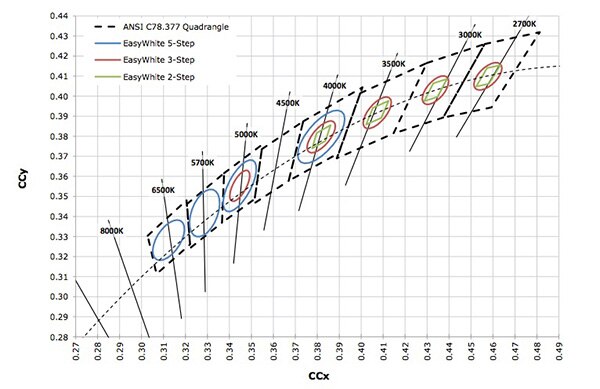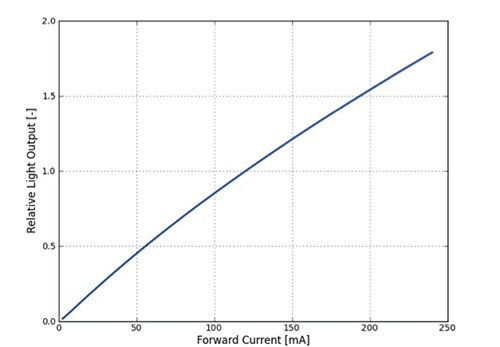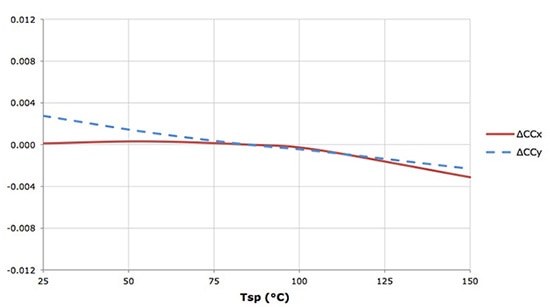Hot Binning Improves LED Consistency at Higher Operating Temperatures
投稿人:电子产品
2015-05-05
Despite the sophistication of LED manufacturing processes, producing LEDs of identical chromaticity and correlated color temperature (CCT) is impossible. Instead, manufacturers sort their completed components into “bins” of devices with closely matched outputs. Engineers then select products from closely matched bins depending on their end-product specification.
The drawback with the traditional method of binning is that the LEDs are typically tested at an arbitrary drive current of 350 mA and junction temperature of 25°C (the typical ambient temperature of the factory). These parameters were satisfactory during the early days of commercial LEDs when devices were treated conservatively to extend lifetime, but today’s tougher chips are driven harder and operating temperatures far exceed the junction temperature used for the binning tests. LED chromaticity drifts with temperature so this difference between test and operating temperature can make it difficult to select the desired chromaticity for a given application.
Recently, however, some pioneering LED makers, such as Cree, have adopted so-called hot binning. Instead of binning their products at 25°C, these manufacturers group their components at 85°C––much closer to today’s typical operating temperatures––improving the precision of chromaticity selection and the consistency of the end products that use the LEDs.
This article looks at the advantages of hot binning and highlights some of the LEDs that benefit from the technique.
Sorting LEDs
LEDs are manufactured using a complex semiconductor fabrication process and governed by the laws of quantum mechanics. Both introduce variation in the chromaticity (color – determined by the wavelength of the photons emitted by the LED), CCT, and optimum forward (driving) voltage of the end product.
In the early days of LED-based mainstream lighting, this introduced a challenge for lighting engineers because nominally identical products emitted different color light (not helped by the eye’s notable ability to detect even the tiniest variations in color). For installations comprising many of these “identical” lamps, this color variation did little to enhance LEDs’ reputation as a quality product.
The solution came in the form of binning, a process whereby chip makers pre-sort LEDs into closely color-matched sets (“bins”) such that an engineer can select components from a small set of adjacent groups to ensure that any color variation in the end products was imperceptible to the consumer. The bins are also sorted to take into account CCT and forward-voltage variations. The technique was borrowed from traditional lighting manufacturers who have also used it to sort color variation in conventional lighting, such as fluorescent and metal-halide devices, for many years.
In the case of LEDs, the bins are defined by a series of chromaticity quadrangles plotted along the “black body” locus in the Commission Internationale de l'Eclairage (CIE) 1931 x, y color space. The quadrangles nominally equate to a narrow range of both CCT and deviation from the black body locus. (See the TechZone article “Defining the Color Characteristics of White LEDs”.) Manufacturers determine to which bin the LED belongs by precisely measuring the output of a sample under pre-determined test conditions. Figure 1 shows the binning quadrangles for Cree’s XLamp MHD-G, a family of mid-power LEDs offering 1335 lm at 106 lm/W (forward current 350 mA, forward voltage 36 V).

Figure 1: Bins for Cree XLamp MHD-G LEDs. (Courtesy of Cree)
There is no hard and fast rule as to the choice of test conditions, but the majority of mainstream manufacturers initially converged on a 350 mA, 3 V driving current/voltage (“1 W” power dissipation) and a 25°C junction temperature. The choice of driving current/voltage made much sense, because it was by far the most common used by LEDs in the field in the early days of the technology. However, the choice of junction temperature was more for convenience rather than to mimic actual operating conditions because it allowed the manufacturer to accelerate the test by checking the LED without waiting for the component to warm up to typical operating temperature before rapidly moving on to the next device.
Early lighting LEDs were fragile and heat in particular was known to kill chips very quickly. Engineers were therefore encouraged to limit junction temperatures in order to provide reasonable life. (See the TechZone article “Understanding the Cause of Fading in High-Brightness LEDs”.) Nonetheless, typical operating temperatures routinely exceeded the 25°C test limit at which the LED was binned. Increasing junction temperatures causes LED chromaticity and CCT to wander in the CIE x, y color space. (See the TechZone article “Thermal Effects on White LED Chromaticity”.)
LED makers argued, with some justification, that such drift was unlikely to move the LED’s x,y coordinates outside the boundaries of the quadrilateral defining the bin and would thus be imperceptible to the consumer. In the worst cases, claimed the manufacturers, engineers could calculate the effect by referring to graphs of extended test results from manufacturers’ data sheets to ensure the desired end result.
However, today’s chips are different; they are much hardier. The key advantage to this increased durability is that engineers can take advantage of the fact that higher drive currents increase luminosity. Figure 2 shows this relationship for a Philips Lumileds LUXEON 3030 LED, an 84 lm, 115 lm/W, (120 mA, 6.1 V) device. By turning up the juice, engineers can reduce the number of LEDs required for a given output, simplifying design and assembly. (See the TechZone article “High Current, High Brightness LEDs Simplify Power Supply Solutions”.)

Figure 2: Luminosity vs. forward current for LUXEON 3030 LED.
The downside is that these higher drive currents push up junction temperatures, increasing the chromaticity drift between the output of the LED at binning and operational temperatures. This relatively large difference between temperatures makes the calculation of chromaticity and CCT shift difficult to calculate. Worse yet, over such a wide range, because chromaticity shift is not the same for every device, even LEDs from the same bin under the same operating conditions might show significant differences in drift, and hence, final output.
Turning up the heat
Some manufacturers have addressed the challenge of characterizing LED output at higher operating temperatures by implementing hot binning. Cree claimed to be the first manufacturer to introduce the technique back in 20111 but has since been joined by several other major firms. This group of companies has converged on a junction temperature of 85°C for hot binning, reasoning that this is a sensible mid-point for the majority of modern applications.
Cree introduced the hot-binned XLamp MT-G in February, 2011 and the product series has subsequently been joined by five additional major Cree XLamp platforms including the latest XM-L2 devices (310 lm, 155 lm/W (700 mA, 2.85 V). Figure 3 shows the effect of temperature on relative chromaticity for XM-L2 devices binned at 85°C (i.e., variation relative to the binning temperature).

Figure 3: Relative chromaticity vs. temperature for Cree XM-L2 LEDs binned at 85°C.
Philips Lumileds and OSRAM also offer hot-binned LEDs. For example, Philips Lumileds’ LUXEON 3020 LEDs (45 lm, 123 lm/W (120 mA, 3.05 V) are tested at 85°C. Similarly OSRAM’s OSLON Square platform (172 lm, 85 lm/W (700 mA, 2.9 V) is tested for binning at the higher temperature.
Hot binning is useful because the starting point for chromaticity shift calculations is much closer to typical operating temperatures than the 25°C test. Nonetheless, an engineer still has to do the math if the system is going to run at any other temperature than 85°C. For example, LEDs used in freezer cases operate at 20-25°C, outdoor luminaires run at 60-65°C and downlights in insulated ceilings or almost any retrofit bulb often operate at over 100°C.
It is also very important to realize that hot binning makes no statement about how quickly the LEDs chromaticity drifts once the temperature deviates from the test point. Better quality devices from reputable manufacturers vary much less over a wide temperature range than lower-specification products.
For more information about the parts discussed in this article, use the links provided to access product information pages on the DigiKey website.
References:
- “LED Binning – Some Like it Hot,” Mark McClear, VP, Applications Engineering, Cree.
免责声明:各个作者和/或论坛参与者在本网站发表的观点、看法和意见不代表 DigiKey 的观点、看法和意见,也不代表 DigiKey 官方政策。






